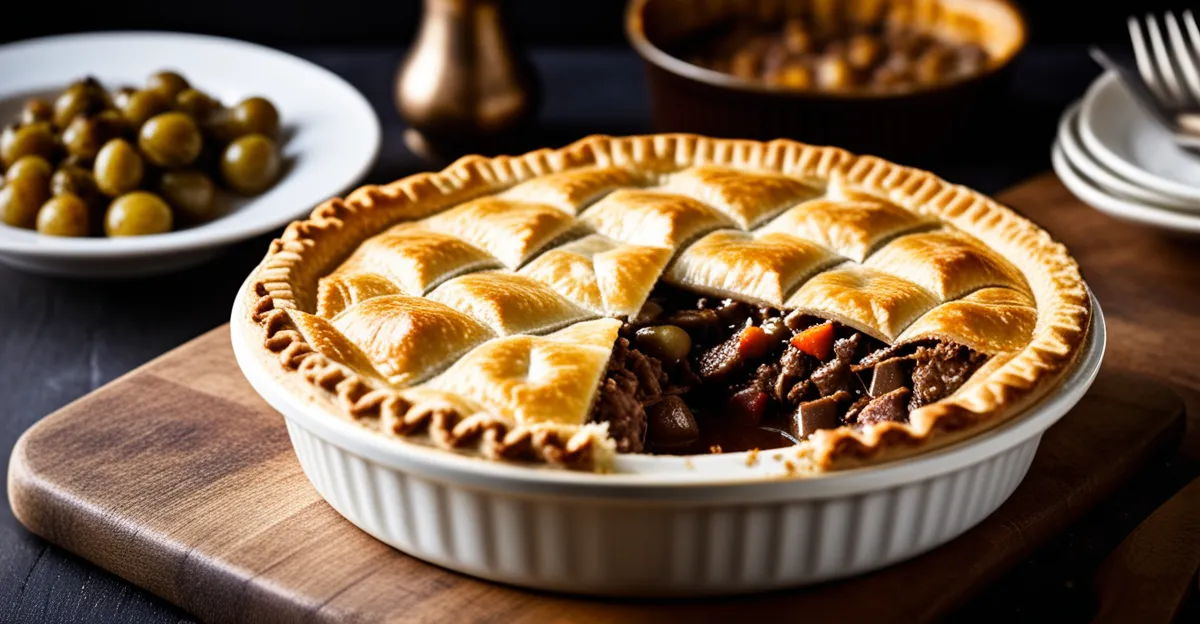Key strategies for making steak and kidney pie healthier
Transforming the classic steak and kidney pie into a healthy steak and kidney pie involves smart swaps and cooking tweaks. Start by choosing lean meats, such as trimmed beef cuts or even poultry, to reduce saturated fat without sacrificing protein. For a twist, consider plant-based options like mushrooms, lentils, or textured vegetable protein, which add fiber and nutrients while maintaining a meaty texture.
Another essential strategy focuses on the pastry. Replacing traditional white flour with whole grain or wholemeal flour can significantly up the fiber content, promoting better digestion and satiety. Additionally, using reduced fat pastry recipes or substituting butter with heart-healthy oils (like olive oil) helps cut calories and unhealthy fats while preserving the pie’s flaky texture.
Have you seen this : How can you make a deliciously authentic sticky toffee pudding?
Incorporate nutrient-boosting techniques such as packing the filling with vegetables like carrots, onions, and celery. These add vitamins, minerals, and moisture, reducing the need for added fats. Using homemade stocks low in sodium rather than commercial versions further supports a healthier traditional recipe. These changes make your pie nutritious meat pie alternatives that satisfy both health goals and taste buds.
Healthier ingredient substitutions and their benefits
Choosing low-fat beef alternatives like trimmed lean cuts or poultry is a foundational step in crafting a healthier steak and kidney pie. Leaner meats contain less saturated fat, which supports heart health without compromising the robust protein content essential for a healthy steak and kidney pie. Alternatively, incorporating plant-based proteins such as mushrooms or textured vegetable protein not only lowers calorie counts but also introduces additional fiber and antioxidants.
Topic to read : What are some innovative ways to serve fish and chips?
Opting for whole-grain pastry instead of traditional white flour pastry enhances fiber intake, which aids digestion and stabilizes blood sugar. Using wholemeal flour also contributes vitamins and minerals absent in refined flours, making it a crucial swap for those aiming to produce healthier traditional recipes with better nutritional profiles. Reducing butter and replacing it with alternatives like olive oil decreases unhealthy fat content while keeping the crust flaky and satisfying.
To bolster nutrition further, preparing the pie with lower sodium recipes is essential. Homemade stocks with less added salt improve flavor without excessive sodium, which benefits overall kidney and cardiovascular health. Adding seasonal vegetables enriches the pie’s nutrient density, making it one of the most nutritious meat pie alternatives you can enjoy. This approach balances taste and health, ensuring each bite delivers flavor and wellness.
Cooking steps for a healthy steak and kidney pie
Crafting a healthy steak and kidney pie starts with selecting lean cuts of steak and kidney, trimming visible fat to reduce calories. Sear the meat using a minimal amount of heart-healthy oil, such as olive oil, to lock in flavour without adding unnecessary fat. Browning the meat properly enhances taste and texture, essential for a satisfying light meat pie.
Next, incorporate plenty of vegetables—carrots, onions, and celery are classic choices—that boost nutrients and moisture. Adding fresh herbs like thyme and rosemary imparts richness without extra salt or fat, supporting easy healthy dinner ideas that still feel indulgent. When seasoning, avoid excessive salt to maintain the benefits of your lower sodium fillings.
For the pastry, roll out whole-grain or wholemeal dough thinly to reduce calories while preserving flakiness. Prick the base slightly before blind baking to prevent sogginess. Bake at moderate heat until the crust turns golden brown, signaling a perfect balance between a crisp exterior and a tender interior.
Following these step-by-step healthy pie recipe techniques ensures a wholesome, satisfying meal. It blends flavour, nutrition, and texture, making this classic dish a standout among nutritious meat pie alternatives.
Key strategies for making steak and kidney pie healthier
Creating a healthy steak and kidney pie hinges on intentional ingredient swaps and thoughtful cooking methods. Prioritising lean meats such as trimmed beef cuts or poultry lowers saturated fat, making the pie more heart-friendly without losing protein richness. Alternatively, integrating plant-based options like mushrooms or lentils boosts fibre and nutrients, positioning the dish among top nutritious meat pie alternatives.
Pastry choice is crucial. Using whole grain or wholemeal flour enhances fibre intake, supporting digestion and prolonging fullness. Combining this with reduced fat alternatives—like substituting butter with olive oil—further trims unhealthy fats while maintaining a pleasing flaky texture. These adjustments align with best practices for crafting healthier traditional recipes.
Techniques that amplify nutrition include packing the filling with vegetables such as carrots, onions, and celery. They add moisture and essential vitamins, allowing you to reduce added fats. Employing homemade stocks low in sodium not only enhances flavour but also cuts excess salt, crucial for a healthy steak and kidney pie. These strategies collectively balance flavour, texture, and health, making the pie a rewarding, wholesome meal choice.
Key strategies for making steak and kidney pie healthier
Transforming steak and kidney pie into a healthy steak and kidney pie involves careful ingredient choices and cooking methods that preserve flavor while enhancing nutrition. Start by choosing lean meats, such as trimmed beef cuts or poultry, to reduce saturated fat without sacrificing protein. Alternatively, integrating plant-based options like mushrooms or lentils introduces fiber and antioxidants, positioning the dish favorably among nutritious meat pie alternatives.
Pastry selection plays a key role. Opting for whole grain or wholemeal flour increases dietary fiber, which aids digestion and prolongs fullness compared to refined flours typical in less healthy versions. To further reduce unhealthy fats, substitute butter with olive oil or other heart-healthy oils, creating healthier traditional recipes with a flaky but lighter crust.
Boosting nutrient density while cutting excess calories can be achieved by packing the filling with vegetables such as carrots, celery, and onions. These not only add vitamins and minerals but also moisture, reducing the need for added fats. Employing homemade stocks with lower sodium supports flavor without overwhelming salt content, complementing the overall strategy to make a balanced, satisfying, and wholesome healthy steak and kidney pie.






